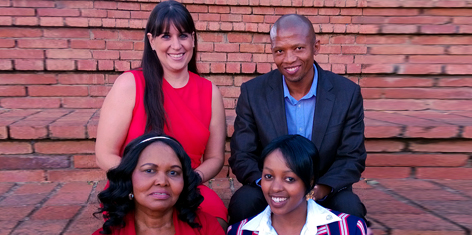
At the event were, from the left: Refiloe Seane, Director: Student Counselling and Development; Anastasia Sehlabo, SRC member for Accessibility and Student Support. Back, from the left: Melissa Barnaschone, Student Counselling and Development; and Mokgawa Kobe, Director: Protection Services.
Photo: Leonie Bolleurs
First-year students receive 1 000 whistles in project to combat crime.
Numerous safety measures were implemented by the University of the Free State in the past five years to ensure the safety of all the students and staff on all three campuses of the UFS. A large area of the UFS Campus is covered by security cameras. Red poles, equipped with panic buttons that can be activated to call for help, were also erected across the campuses.
At the beginning of 2013, as a further safety measure, whistles were handed out to female students in residences.
At an event on 26 March 2014, Refiloe Seane, Director: Student Counselling and Development, together with her team, handed over 1 000 whistles to the Student Representative Council to be distributed to first-year students. The whistles were sponsored by Prof Nicky Morgan, Vice-Rector: Operations and Mokgawa Kobe, Director: Protection Services.
“Female students are encouraged to use the whistles to call for help when they feel unsafe or are in danger. The objective is, firstly, to discourage criminals without suffering any negative consequences, and secondly, to get the attention of security or any other form of assistance,” said Melissa Barnaschone, Student Counselling and Development.
At the event, Mokgawa said: “The moment you blow this whistle, you say to the potential criminal:
- I hate what you do
- I will not keep quiet about it
- I am doing something against crime.”